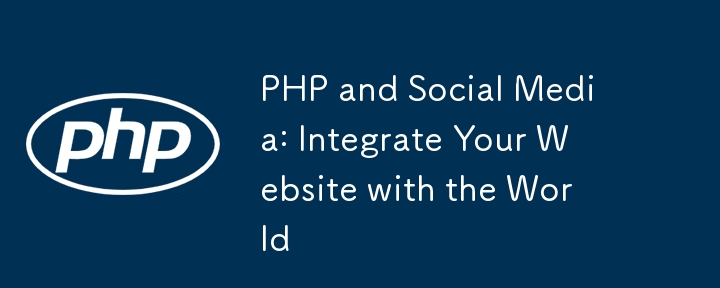PHP provides tools to allow websites to easily integrate social media functions: 1. Dynamically generate social media sharing buttons for users to share content; 2. Integrate with the OAuth library to achieve seamless social media login; 3. Use the HTTP library to capture Get social media data and obtain user profiles, posts and other information.

PHP and Social Media: Make your website global
Introduction
Social media has become an integral part of the modern web, providing businesses and individuals with a valuable platform to interact with their audiences, promote products and build communities. PHP, a popular web development language, provides a range of tools to easily integrate social media functionality into your website.
Use PHP to integrate social media
1. Social media sharing button
You can use PHP to dynamically generate social media sharing Buttons that allow users to share content directly from your site.
$url = 'https://example.com/post'; $title = 'This is an example post'; echo '<a href="https://www.facebook.com/sharer/sharer.php?u=' . urlencode($url) . '" target="_blank">Share on Facebook</a>';
2. Social Media Login
PHP can be integrated with OAuth library for seamless social media login. This allows users to log into your website using their social media accounts, reducing the sign-up process and increasing convenience.
require_once 'vendor/autoload.php';
$provider = new \League\OAuth2\Client\Provider\Facebook([
'clientId' => 'YOUR_CLIENT_ID',
'clientSecret' => 'YOUR_CLIENT_SECRET',
'redirectUri' => 'YOUR_REDIRECT_URI'
]);3. Social media data capture
PHP can use cURL or other HTTP request libraries to capture social media data, such as user profiles, time Line posts and tweets.
$ch = curl_init('https://api.twitter.com/1.1/statuses/user_timeline.json?screen_name=php');
curl_setopt($ch, CURLOPT_RETURNTRANSFER, true);
curl_setopt($ch, CURLOPT_USERPWD, 'YOUR_CONSUMER_KEY:YOUR_CONSUMER_SECRET');
$tweets = json_decode(curl_exec($ch));Practical case
Blog website and Facebook integration
A Facebook integration on a PHP blog website The specific case is as follows:
- Using PHP to generate a Facebook share button, allowing users to share articles to Facebook.
- Integrated OAuth2 and implemented Facebook login function, allowing readers to log in with their Facebook account to comment and write articles.
- Crawled the Facebook API using cURL to get the user profile information and latest articles displayed in the website's home page.
Through these integrations, blogging sites effectively harness the power of social media to increase user engagement, increase sharing, and build an active community.
Conclusion
By leveraging the tools provided by PHP, you can easily integrate social media features into your website. From share buttons to social media logins and data scraping, use these technologies to improve user experience, increase website traffic, and reach a wider audience.
The above is the detailed content of PHP and Social Media: Integrate Your Website with the World. For more information, please follow other related articles on the PHP Chinese website!
 php怎么把负数转为正整数Apr 19, 2022 pm 08:59 PM
php怎么把负数转为正整数Apr 19, 2022 pm 08:59 PMphp把负数转为正整数的方法:1、使用abs()函数将负数转为正数,使用intval()函数对正数取整,转为正整数,语法“intval(abs($number))”;2、利用“~”位运算符将负数取反加一,语法“~$number + 1”。
 php怎么设置implode没有分隔符Apr 18, 2022 pm 05:39 PM
php怎么设置implode没有分隔符Apr 18, 2022 pm 05:39 PM在PHP中,可以利用implode()函数的第一个参数来设置没有分隔符,该函数的第一个参数用于规定数组元素之间放置的内容,默认是空字符串,也可将第一个参数设置为空,语法为“implode(数组)”或者“implode("",数组)”。
 php怎么去除首位数字Apr 20, 2022 pm 03:23 PM
php怎么去除首位数字Apr 20, 2022 pm 03:23 PM去除方法:1、使用substr_replace()函数将首位数字替换为空字符串即可,语法“substr_replace($num,"",0,1)”;2、用substr截取从第二位数字开始的全部字符即可,语法“substr($num,1)”。
 php怎么给数组增加一个数组元素Apr 19, 2022 pm 08:45 PM
php怎么给数组增加一个数组元素Apr 19, 2022 pm 08:45 PM增加元素的方法:1、使用“array_unshift(数组,数组元素)”语句,在数组的开头添加元素;2、使用“array_push(数组,数组元素)”语句,在数组的末尾添加元素;3、用“array_pad(数组,数组长度+1,元素)”语句。
 php怎么统计数组里同一个值有几个Apr 19, 2022 pm 08:26 PM
php怎么统计数组里同一个值有几个Apr 19, 2022 pm 08:26 PM在php中,可以使用array_count_values()函数来统计数组里同一个值有几个,语法为“array_count_values($array)”;该函数会返回一个关联数组,其元素的键名是原数组的值,键值是该值在原数组中出现的次数。
 PHP and Social Media: Integrate Your Website with the WorldOct 11, 2024 am 11:54 AM
PHP and Social Media: Integrate Your Website with the WorldOct 11, 2024 am 11:54 AMPHP提供了工具,让网站轻松整合社交媒体功能:1.动态生成社交媒体分享按钮,供用户分享内容;2.与OAuth库集成,实现无缝社交媒体登录;3.使用HTTP库抓取社交媒体数据,获取用户个人资料、帖子等信息。
 提升社交媒体平台顶部导航栏功能的固定定位效果Jan 20, 2024 am 08:45 AM
提升社交媒体平台顶部导航栏功能的固定定位效果Jan 20, 2024 am 08:45 AM固定定位增强社交媒体平台的顶部导航栏功能在当今社交媒体的盛行时代,拥有一个功能强大的顶部导航栏对于社交媒体平台来说至关重要。顶部导航栏不仅可以提供用户导航网站的便利性,还能提升用户体验。本文将介绍如何通过固定定位增强社交媒体平台的顶部导航栏功能,并提供具体的代码示例。一、为什么要固定定位顶部导航栏?固定定位可以使顶部导航栏始终保持在屏幕的顶部,无论用户向下滚
 PHP社交媒体应用的点赞与分享功能解析Aug 09, 2023 pm 01:06 PM
PHP社交媒体应用的点赞与分享功能解析Aug 09, 2023 pm 01:06 PMPHP社交媒体应用的点赞与分享功能解析随着社交媒体的飞速发展,点赞与分享功能已经成为了现代应用开发的重要组成部分之一。在这篇文章中,我们将探讨使用PHP语言实现社交媒体应用中的点赞与分享功能,并提供一些代码示例供参考。一、点赞功能的实现点赞功能是用户对某个内容表示喜欢的一种方式。在实现点赞功能时,我们需要考虑以下几个方面:数据库设计为了存储用户的点赞信息,我


Hot AI Tools

Undresser.AI Undress
AI-powered app for creating realistic nude photos

AI Clothes Remover
Online AI tool for removing clothes from photos.

Undress AI Tool
Undress images for free

Clothoff.io
AI clothes remover

AI Hentai Generator
Generate AI Hentai for free.

Hot Article

Hot Tools

VSCode Windows 64-bit Download
A free and powerful IDE editor launched by Microsoft

MantisBT
Mantis is an easy-to-deploy web-based defect tracking tool designed to aid in product defect tracking. It requires PHP, MySQL and a web server. Check out our demo and hosting services.

mPDF
mPDF is a PHP library that can generate PDF files from UTF-8 encoded HTML. The original author, Ian Back, wrote mPDF to output PDF files "on the fly" from his website and handle different languages. It is slower than original scripts like HTML2FPDF and produces larger files when using Unicode fonts, but supports CSS styles etc. and has a lot of enhancements. Supports almost all languages, including RTL (Arabic and Hebrew) and CJK (Chinese, Japanese and Korean). Supports nested block-level elements (such as P, DIV),

Dreamweaver CS6
Visual web development tools

SublimeText3 Mac version
God-level code editing software (SublimeText3)





